In November, we installed Metalworking Now, a new display in the V&A’s Silver Galleries which showcases recent acquisitions by remarkable contemporary metalworkers. Two previous blog posts discuss how we went about selecting some of the objects, and introduce some of the makers.
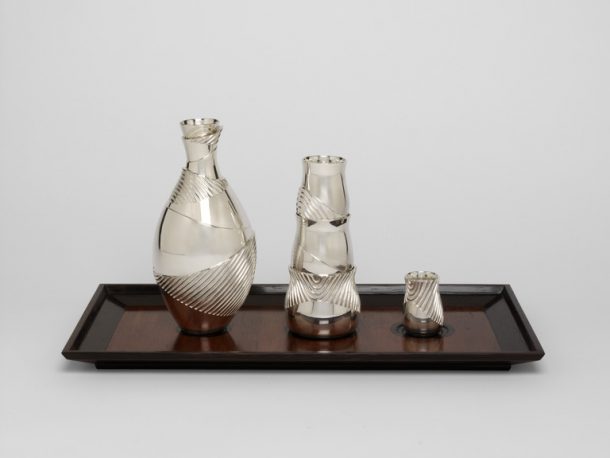
Museum no. M.29-201. © Victoria and Albert Museum, London
For this blog post, I visited the studio of Kyosun Jung, whose silver sake set is included in the display. Based at the Goldsmiths’ Centre in London, Kyosun specialises in contemporary silverware, jewellery and art medals. In 2013, she submitted a 3D-printed prototype for a sake set to the Goldsmiths’ Company’s Young Designer Silversmith competition, an initiative which encourages students to show their artistic individuality in silver. Kyosun’s prototype won the award. I was interested to know how she went about making the set, how it came to be acquired by the V&A, and to find out more about her practice and inspiration behind her work.
What led you to become a silversmith?
It all started when I was a student at the University for the Creative Arts (UCA Rochester). I already had that initial attraction to working with metals, and I was studying silversmithing, goldsmithing and jewellery. I was more interested in being a jeweller – I wanted to make my own jewellery that I could wear. It was only later that I fell in love with hammering and soldering: how these techniques change the shape of metal, how soldering joins pieces together…it’s amazing. I still do a lot of commissions for engagement and wedding rings, but my preference is working on a larger scale.
In 2013, you won the Young Designer Silversmith award, a nationwide student scheme run by the Goldsmiths’ Company. Can you tell us what inspired you to create a sake set for this?
I heard about the Young Designer Silversmith competition in my second year at Rochester. The brief for that year was to design a drinking set for a particular alcoholic spirit and the set should comprise of a tray and at least four drinking vessels. I researched Japanese and Korean vessels for sake, an alcoholic beverage of Japanese origin made from fermented rice. I spent a lot of time researching their variations. Sake bottles and cups look so different from European drinking vessels, and I wanted my final design to blend these characteristics with those of bamboo.
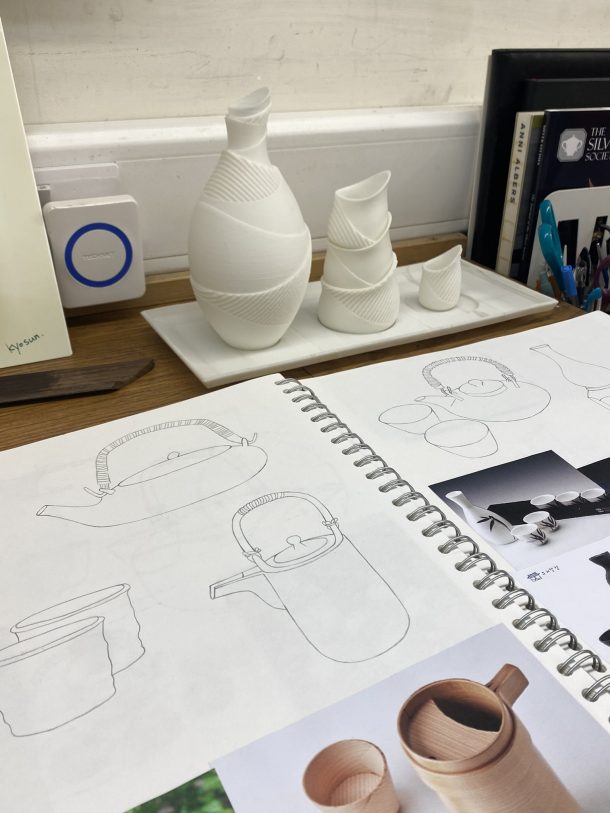
In Korea, we have a lot of really beautiful bamboo. I have childhood memories of travelling with my family and enjoying being in bamboo forests, those greens, the amazing sounds of a bamboo forest in the wind… I did some research and discovered that bamboo shoots (the baby plants) have really interesting shapes and lines. I started drawing on paper to see how I could include their structure and details in my vessels.
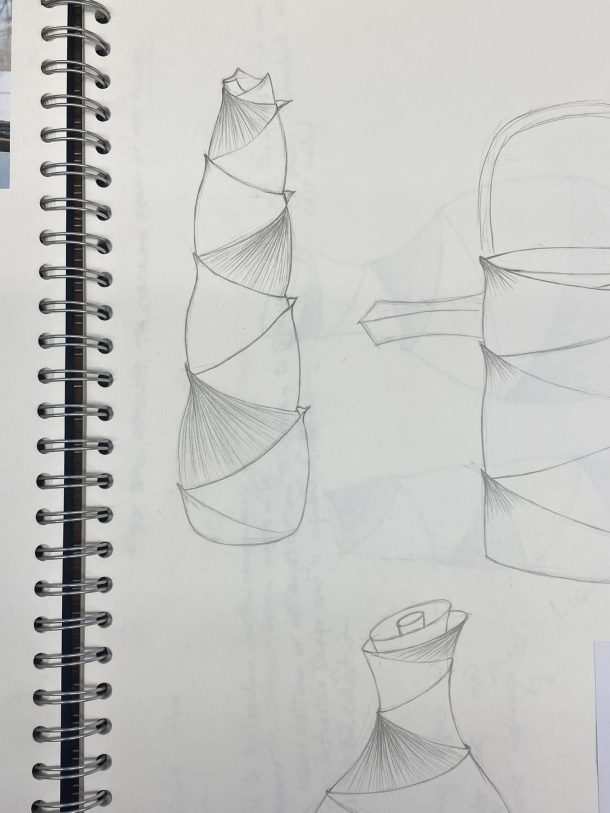
How did you combine traditional silversmithing techniques with digital design? Do your designs start with pen and paper or is your designing process solely computer-based?
For the design of the sake set, I did hand drawings first and then I moved onto 3D Rhino CAD (Computer Aided Design software for 3D graphics). It was my first time learning computer drawing in this school and I wasn’t very good! Every morning at 9 am I would queue up for the computer area so that when they opened the door I could go in and learn little-by-little. The tutor was always there, so I had someone who could advise me on how to make the shapes I wanted to achieve.
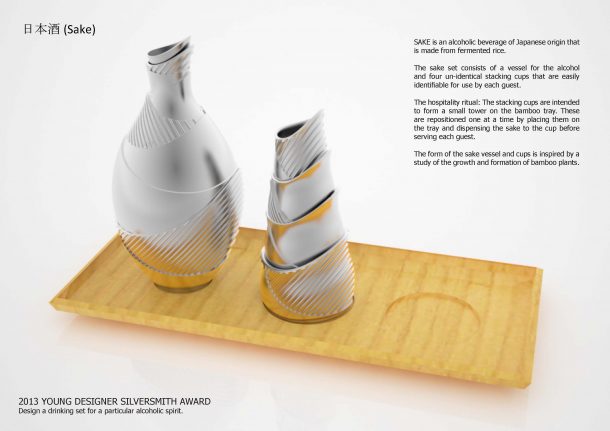
I needed to hand in models as part of my application and so the tutor suggested 3D printing. At that time, 3D printing was not at all popular, but I had a 3D printed prototype made for me in a type of nylon.
Today it really depends on what I am working on. With smaller pieces, I usually use CAD drawing, 3D printing and then casting. With larger pieces, 3D printing or wax casting wouldn’t work, so I will use techniques such as hammering, soldering, and cutting by hand.
How did winning the Young Designer Silversmith award lead you to make your sake set and donate it to the V&A’s Metalwork collections? What does the award mean to you today?
Because I was a second-year student I didn’t yet have making skills and so after winning the award, the Goldsmith’s Company sent me to the workshop of Clive Burr, an internationally acclaimed English silversmith whose studio is in the Goldsmiths’ Centre in London. Making the set was a real challenge. I was living in Rochester at the time and so I took the train every morning to London to learn in Clive’s studio. I did this for three months, making the set solely in the workshop. I think I learnt more from those three months working with him than my three years in university.
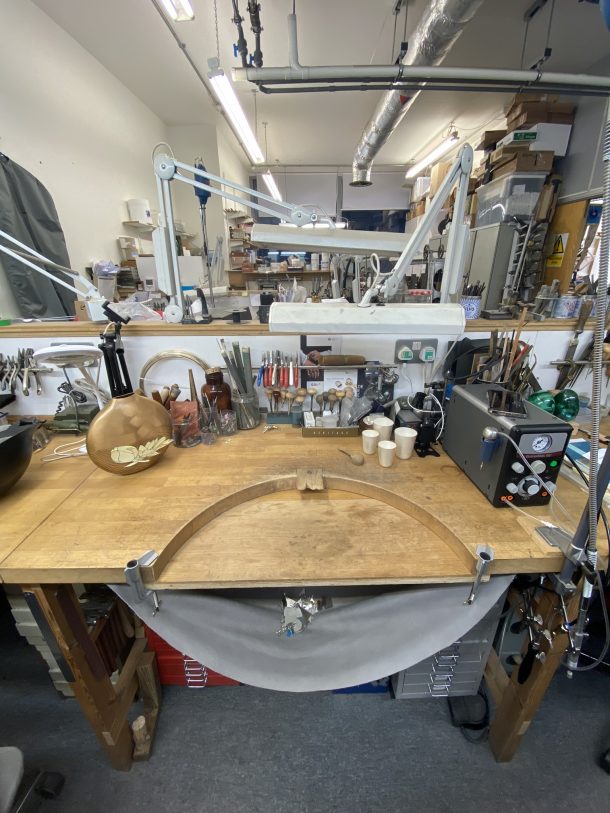
As part of the award, my piece would be donated to a museum, but what I didn’t know while making the set was that it would be donated to the V&A! I felt really lucky. I think of the sake set as my first baby. The award and the donation to the V&A were a big turning point for me and my career. When I graduated in 2014, I was really struggling with getting a visa to stay in the UK, but the V&A, the British Museum, and the Goldsmiths’ Company all came together to support my application. For me, that piece was life changing.
I don’t feel that there is a market in Korea for the silver pieces that I make. There is a preference for gold or big-branded pieces rather than designer pieces. For me, the UK is the biggest market for these one-off pieces, and I feel that everyone really appreciates the inspiration, the techniques, and the processes of making. People genuinely appreciate my work, and this motivates me to work even harder to make something new or different.
Could you summarise how the silver vessels were made?
Clive and I had an initial discussion about how to go about making the set. There were several options including casting, prototyping, and 3D printing, but Clive showed me a very traditional way to make it.
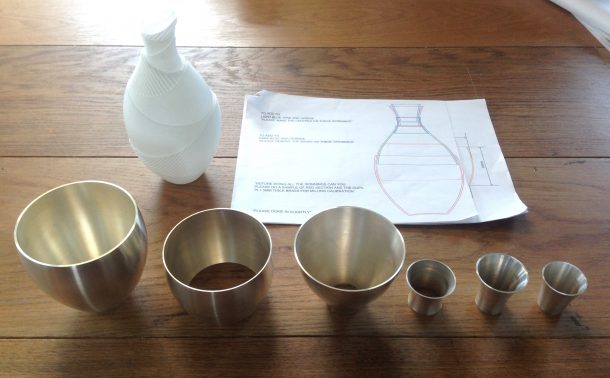
For the sake bottle, the English master spinner Stefan Coe helped me with the cups and beaker components. The process of spinning involves shaping a flat silver disc into a hollow item, like a bowl, cup or vessel. I used a lathe to spin each disc whilst shaping it over a wood former. I needed a regular thickness for each component, so I felt spinning would be better than hand raising. We spun six silver components of decreasing size, including the stopper. After that, I bent silver wires for the decoration and soldered them into each part. I then stacked the parts at right angles from each other and then I soldered them; second component to first, third to second… a lot of soldering! I feel quite confident with soldering now as I’ve had a lot of practice.
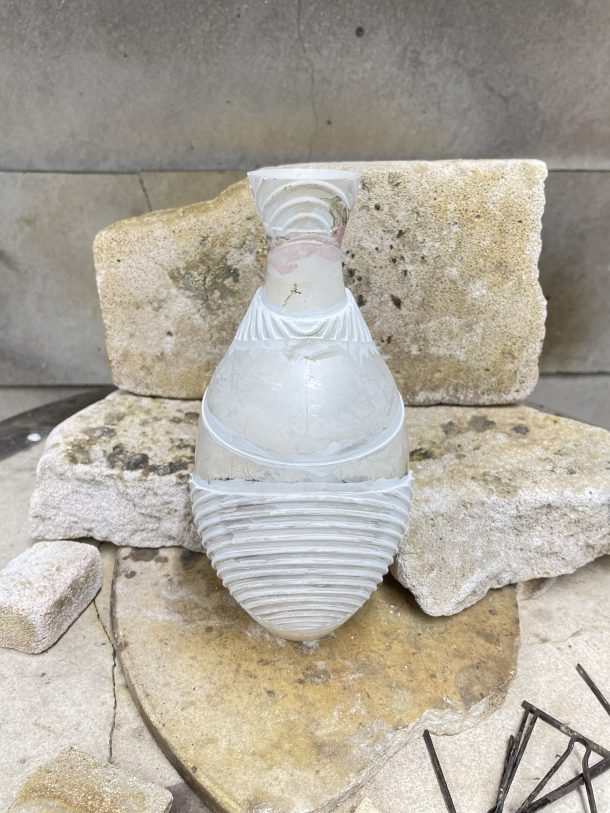
Afterwards, I hand engraved the surface and cut between the wires to create texture. All the undulating details on the surface were actually individual wires which were bent by hand and then soldered on. It takes longer, but the finish is a lot better.
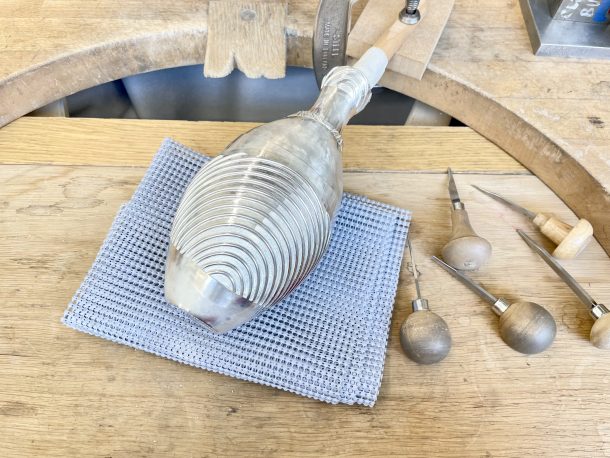
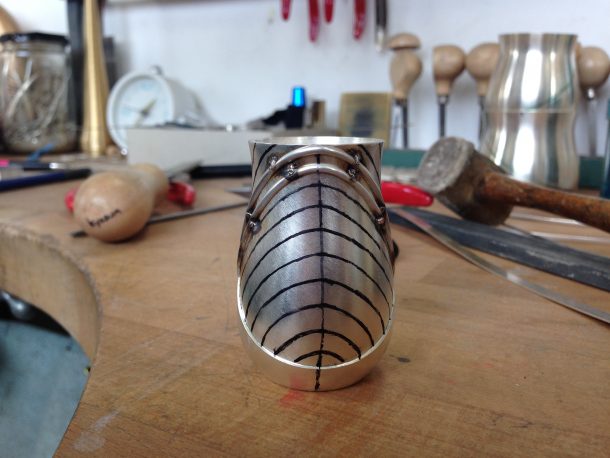
The sake set not only includes silver but also wood. What led you to your decision to combine these materials? How did you go about making the tray?
In Korea, when we serve tea, dinner, or when we carry anything, it is usually on wood trays, so I thought this would be an important and traditional inclusion. I really wanted to have bamboo in the middle, that was my original idea, but with a little bit of colour contrast. Clive has a lot of different woods in his studio, and he gave me samples so I was able to choose which colours would work best.
I decided to make the tray’s interior with bamboo and the exterior with wenge, an Africa wood, to have a contrast of colours. Wenge is typically dark, and bamboo a little bit lighter. I didn’t have any experience of woodwork, so Clive showed me how to go about cutting the wood at right angles, using the machinery, and doing the joins.
More recently, you have introduced enamelling into your work. How did you get into this?
When I was a student, I had a lot of ideas, a lot of pieces I wanted to make and explore. In the school, there were two kilns, 30 students and only one teacher who taught us enamelling once a week. I sort of understood how enamel works; it’s glass, you grind it, clean it, put it on the silver, and put that in the kiln. I understood the method, but sometimes the enamel wouldn’t melt, or it melted too much and so you need a lot of practice! It wasn’t easy and I didn’t really have time to make many test pieces in school. For my final project in the university, I designed the Reversible Drinking Set. I like adding colour to silver and I wanted to enamel certain areas of the vessels, so Clive suggested contacting the enameller Jane Short. I went to her workshop to learn the very basic skills of grinding the enamel, putting objects in the kiln, and taking them out. Jane showed me very basic things, step-by-step, and I developed the skills to enamel on curved surfaces.
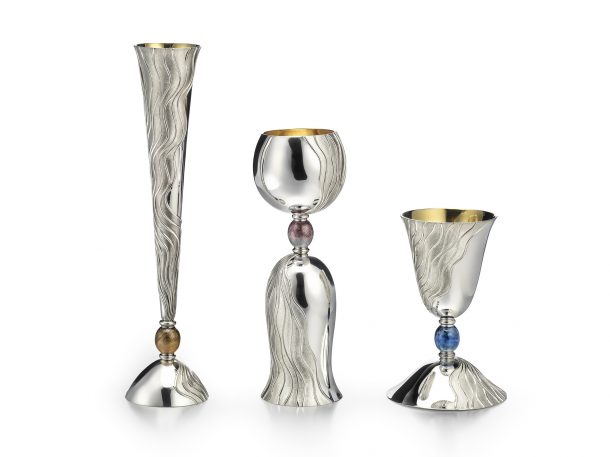
What do you enjoy most about working in silver?
When you go to the Goldsmiths’ Fair (an annual fair for silversmiths and jewellers organised by the Worshipful Company of Goldsmiths and held at the Goldsmiths’ Hall), everyone is using similar materials, but I find it amazing how all these incredible makers can create such different designs and ideas. Anything can be made from a flat sheet of metal, from a vase to a pair of chased cups. I also love that metal can be melted down. A recent client bought a couple of big pieces from me and asked me whether anything could be done with her family’s heirloom jewellery. We have been discussing how the gold and the precious stones could be taken out and reused, so she can remember her family but enjoy modern jewellery that she is more likely to wear. This allowed me to think creatively and work in a more sustainable way by recycling those materials. That’s a great project I’m really excited to work on this year.
What advice would you give to aspiring makers today?
When I meet with students, I always tell them it is so important to create their own style, not to copy anyone else’s work. I remember when I was a student, I was always trying to do something else. But like with most students in a class, if one person picks a mushroom, then everyone else will start picking mushrooms! Clients seek originality and uniqueness rather than similarity to other makers’ work, so I always tell them to really think about and search for their own style.
It is also so important to learn to draw and to make models in paper, plastic or wood, to see the volume before you attempt to make your work. I always make a lot of models, whether in paper or wood, exactly the same size as how I want to make my final piece in silver. You get a better idea of different sizes, scales, and volume, and then you change that a little bit and only then can you move on to precious materials to make the final piece. When I am working, I am incredibly picky. If a line isn’t straight, even by one millimeter, I can tell with my eyes! I have trained my eye through many years of learning from people like Clive Burr, Jane Short, Angus McFadyen, and Malcolm Appleby. Seeing these craftspeople in their workshops, observing what they do, I have learnt the importance of precise and picky eyes, and most importantly, patience!



Your work is fantastic, really beautiful and unlike I have ever seen before. I wish you continued success.